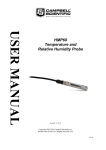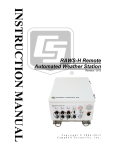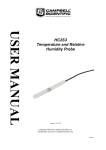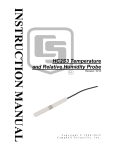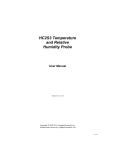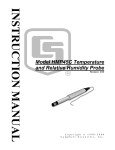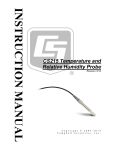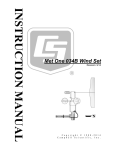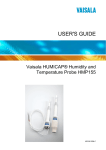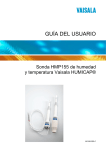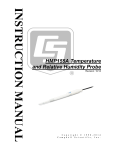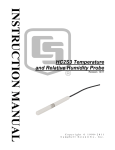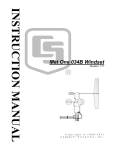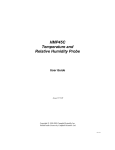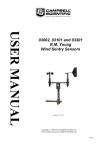Download Vaisala HMP60 Product manual
Transcript
HMP60 Temperature and Relative Humidity Probe Revision: 7/12 C o p y r i g h t © 1 9 9 5 - 2 0 1 2 C a m p b e l l S c i e n t i f i c , I n c . Warranty “PRODUCTS MANUFACTURED BY CAMPBELL SCIENTIFIC, INC. are warranted by Campbell Scientific, Inc. (“Campbell”) to be free from defects in materials and workmanship under normal use and service for twelve (12) months from date of shipment unless otherwise specified in the corresponding Campbell pricelist or product manual. Products not manufactured, but that are re-sold by Campbell, are warranted only to the limits extended by the original manufacturer. Batteries, fine-wire thermocouples, desiccant, and other consumables have no warranty. Campbell's obligation under this warranty is limited to repairing or replacing (at Campbell's option) defective products, which shall be the sole and exclusive remedy under this warranty. The customer shall assume all costs of removing, reinstalling, and shipping defective products to Campbell. Campbell will return such products by surface carrier prepaid within the continental United States of America. To all other locations, Campbell will return such products best way CIP (Port of Entry) INCOTERM® 2010, prepaid. This warranty shall not apply to any products which have been subjected to modification, misuse, neglect, improper service, accidents of nature, or shipping damage. This warranty is in lieu of all other warranties, expressed or implied. The warranty for installation services performed by Campbell such as programming to customer specifications, electrical connections to products manufactured by Campbell, and product specific training, is part of Campbell’s product warranty. CAMPBELL EXPRESSLY DISCLAIMS AND EXCLUDES ANY IMPLIED WARRANTIES OF MERCHANTABILITY OR FITNESS FOR A PARTICULAR PURPOSE. Campbell is not liable for any special, indirect, incidental, and/or consequential damages.” Assistance Products may not be returned without prior authorization. The following contact information is for US and international customers residing in countries served by Campbell Scientific, Inc. directly. Affiliate companies handle repairs for customers within their territories. Please visit www.campbellsci.com to determine which Campbell Scientific company serves your country. To obtain a Returned Materials Authorization (RMA), contact CAMPBELL SCIENTIFIC, INC., phone (435) 227-9000. After an applications engineer determines the nature of the problem, an RMA number will be issued. Please write this number clearly on the outside of the shipping container. Campbell Scientific's shipping address is: CAMPBELL SCIENTIFIC, INC. RMA#_____ 815 West 1800 North Logan, Utah 84321-1784 For all returns, the customer must fill out a "Statement of Product Cleanliness and Decontamination" form and comply with the requirements specified in it. The form is available from our web site at www.campbellsci.com/repair. A completed form must be either emailed to [email protected] or faxed to (435) 227-9106. Campbell Scientific is unable to process any returns until we receive this form. If the form is not received within three days of product receipt or is incomplete, the product will be returned to the customer at the customer's expense. Campbell Scientific reserves the right to refuse service on products that were exposed to contaminants that may cause health or safety concerns for our employees. HMP60 Table of Contents PDF viewers: These page numbers refer to the printed version of this document. Use the PDF reader bookmarks tab for links to specific sections. 1. Introduction..................................................................1 2. Cautionary Statements................................................1 3. Initial Inspection ..........................................................1 4. Quickstart .....................................................................2 4.1 Step 1 — Mount the Probe .......................................................................2 4.2 Step 2 — Use SCWin Short Cut to Program Datalogger and Generate Wiring Diagram......................................................................5 5. Overview.......................................................................7 6. Specifications ..............................................................8 6.1 Temperature Sensor ..................................................................................9 6.2 Relative Humidity Sensor.........................................................................9 7. Installation..................................................................10 7.1 7.2 7.3 7.4 Siting.......................................................................................................10 Mounting and Assembly.........................................................................10 Wiring.....................................................................................................11 Programming ..........................................................................................11 7.4.1 Example for CR1000 ....................................................................12 7.4.2 Example for CR10X .....................................................................13 7.5 Long Lead Lengths.................................................................................13 7.6 Absolute Humidity..................................................................................14 7.6.1 CR1000 Vapor Pressure Example.................................................15 7.6.2 Sample CR10(X) Program that Computes Vapor Pressure and Saturation Vapor Pressure ..................................................16 8. Maintenance ...............................................................17 8.1 Procedure for Removing RH Chip .........................................................17 9. Troubleshooting ........................................................18 10. References ...............................................................18 i HMP60 Table of Contents Figures 4-1. 4-2. 4-3. 4-4. 7-1. 8-1. HMP60 as shipped.................................................................................. 3 HMP60 and 41303-5A Radiation Shield on a tripod mast ..................... 3 HMP60 and 41303-5A Radiation Shield on a CM202 Crossarm........... 4 HMP60 and 41303-5A Radiation Shield................................................ 4 HMP60 wiring ...................................................................................... 11 Exploded view of HMP60 (as shipped)................................................ 17 5-1. 7-1. 7-2. 7-3. 7-4. 7-5. Recommended Lead Lengths ................................................................. 8 Datalogger Connections ....................................................................... 11 Calibration for Temperature ................................................................. 12 Calibration for Relative Humidity ........................................................ 12 Wiring for CR1000 and CR10X Examples .......................................... 12 Wiring for Vapor Pressure Examples ................................................... 15 Tables ii HMP60 Temperature and Relative Humidity Probe 1. Introduction The HMP60 probe measures temperature for the range of -40° to 60°C, and relative humidity for the range of 0 to 100% RH. It is suitable for long-term, unattended monitoring, and is compatible with all Campbell Scientific dataloggers. Before using the HMP60, please study • • • Section 2, Cautionary Statements Section 3, Initial Inspection Section 4, Quickstart More details are available in the remaining sections. 2. Cautionary Statements • Care should be taken when opening the shipping package to not damage or cut the cable jacket. If damage to the cable is suspected, consult with a Campbell Scientific applications engineer. • Although the HMP60 is rugged, it should be handled as a precision scientific instrument. • The black outer jacket of the cable is Santoprene® rubber. This compound was chosen for its resistance to temperature extremes, moisture, and UV degradation. However, this jacket will support combustion in air. It is rated as slow burning when tested according to U.L. 94 H.B. and will pass FMVSS302. Local fire codes may preclude its use inside buildings. • Remember to remove the yellow cap prior to installation. 3. Initial Inspection • Upon receipt of the HMP60, inspect the packaging and contents for damage. File damage claims with the shipping company. • The model number and cable length are printed on a label at the connection end of the cable. Check this information against the shipping documents to ensure the correct product and cable length are received. • The HMP60 is shipped with an instruction manual or a ResourceDVD. 1 HMP60 Temperature and Relative Humidity Probe 4. Quickstart 4.1 Step 1 — Mount the Probe Review Section 7, Installation for complete instructions. To install the HMP60, you will need: • • • • • • CAUTION 2 41305-5A 6-plate Radiation Shield 1/2" open end wrench small screw driver provided with datalogger small Phillips screwdriver UV resistant cable ties small pair of diagonal-cutting pliers 1. Pull off the yellow shipping cap (see Figure 4-1). 2. Loosen the plastic split collar at the base of the shield (reversing the removable portion if necessary) and gently insert the probe. 3. Tighten the mounting clamp until it lightly grips the probe body (see Figure 4-4). 4. Continue to push the probe up into the body of the shield until the step in the tube stops it from going any further. 5. Tighten the collar until it securely grips the probe (see Figure 4-4). 6. Attach the radiation shield to the tripod mast, crossarm, or tower leg using the supplied U-bolt. See Figures 4-2 and 4-3 for examples of shield mounting. 7. Route the cable to the datalogger, and secure the cable to the mounting structure using cable ties. Failure to secure the cable can lead to breakage of the wires due to fatigue if the cable is allowed to blow back and forth in the wind. HMP60 Temperature and Relative Humidity Probe Yellow Shipping Cap (remove before installation) FIGURE 4-1. HMP60 as shipped FIGURE 4-2. HMP60 and 41303-5A Radiation Shield on a tripod mast 3 HMP60 Temperature and Relative Humidity Probe FIGURE 4-3. HMP60 and 41303-5A Radiation Shield on a CM202 Crossarm Mounting Clamp FIGURE 4-4. HMP60 and 41303-5A Radiation Shield 4 HMP60 Temperature and Relative Humidity Probe 4.2 Step 2 — Use SCWin Short Cut to Program Datalogger and Generate Wiring Diagram The simplest method for programming the datalogger to measure the HMP60 is to use Campbell Scientific's SCWin Short Cut Program Generator. 1. Open Short Cut and click on New Program. 2. Select a datalogger and scan interval. 5 HMP60 Temperature and Relative Humidity Probe 6 3. Select HMP50/HMP60 Temperature and Relative Humidity Sensor then click the right arrow to add it to the list of sensors to be measured. 4. Define the name of the public variables. Variables default to AirTC and RH that hold the air temperature and relative humidity measurements. Select the desired units of measure. Units default to Deg C. HMP60 Temperature and Relative Humidity Probe 5. Choose the outputs for the AirTC and RH and then select finish. 6. Wire according to the wiring diagram generated by SCWin Short Cut. 5. Overview The HMP60 Temperature and Relative Humidity probe contains a Platinum Resistance Temperature detector (PRT) and a Vaisala INTERCAP® capacitive relative humidity sensor. The -L option on the model HMP60 Temperature and Relative Humidity probe (HMP60-L) indicates that the cable length is user specified. Cable length is specified when the sensor is ordered. Table 5-1 gives the recommended cable length. This manual refers to the sensor as the HMP60. 7 HMP60 Temperature and Relative Humidity Probe TABLE 5-1. Recommended Lead Lengths 2 m Height Atop a tripod or tower via a 2 ft crossarm such as the CM202 Mast/Leg CM202 CM6 CM10 CM110 CM115 CM120 UT10 UT20 UT30 9' 11' 11' 14' 14' 19' 24' 14' 24' 37' Note: Add two feet to the cable length if you are mounting the enclosure on the leg base of a light-weight tripod. The probe’s cable can terminate in: • • • • Pigtails that connect directly to a Campbell Scientific datalogger (option –PT). Connector that attaches to a prewired enclosure (option –PW). Refer to www.campbellsci.com/prewired-enclosures for more information. Connector that attaches to a CWS900 Wireless Sensor Interface (option –CWS). The CWS900 allows the probe to be used in a wireless sensor network. Refer to www.campbellsci.com/cws900 for more information. Connector that attaches to a CS110 Electric Field Meter or an ETseries weather station (option –C). Refer to www.campbellsci.com/cs110-sensor for more information. 6. Specifications Features: • Field -replaceable humidity chip eliminates recalibration down time • Compatible with all Campbell Scientific dataloggers (including the CR200(X) series) • Compatible with the CWS900-series interfaces, allowing it to be used in a wireless sensor network Compatibility Dataloggers: 8 CR200(X) series CR800 series CR1000 CR3000 CR5000 CR9000(X) CR7X CR510 CR10(X) CR23X 21X Operating Temperature: -40° to +60°C Probe Length: 7.1 cm (2.8 in) HMP60 Temperature and Relative Humidity Probe Probe Body Diameter: 1.2 cm (0.47 in) Filter: 0.2 μm Teflon membrane Filter Diameter: 1.2 cm (0.47 in) Housing Body Material: Filter Cap Material: Classification: AISI 316 stainless steel Chrome-coated ABS plastic IP65 Power Consumption: 1 mA typical; 5 mA maximum Supply Voltage: 5 to 28 Vdc Settling Time after power is switched on: 1 second Output Signal Range: 0 to 1 Vdc 6.1 Temperature Sensor Sensor: 1000 Ω PRT, DIN 43760B Temperature Measurement Range: -40° to +60°C Temperature Accuracy: ±0.6°C (-40° to +60°C) 6.2 Relative Humidity Sensor Sensor: INTERCAP® Relative Humidity Measurement Range: 0 to 100% non-condensing Accuracy at 0° to +40°C: Accuracy at -40° to 0°C and +40° to +60°C: CAUTION ±3% RH (0 to 90% Relative Humidity) ±5% RH (90 to 100% Relative Humidity) ±5% RH (0 to 90% Relative Humidity) ±7% RH (90 to 100% Relative Humidity) The black outer jacket of the cable is Santoprene® rubber. This compound was chosen for its resistance to temperature extremes, moisture, and UV degradation. However, this jacket will support combustion in air. It is rated as slow burning when tested according to U.L. 94 H.B. and will pass FMVSS302. Local fire codes may preclude its use inside buildings. 9 HMP60 Temperature and Relative Humidity Probe 7. Installation 7.1 Siting Sensors should be located over an open level area at least 9 m (EPA) in diameter. The surface should be covered by short grass, or where grass does not grow, the natural earth surface. Sensors should be located at a distance of at least four times the height of any nearby obstruction, and at least 30 m (EPA) from large paved areas. Sensors should be protected from thermal radiation, and adequately ventilated. Standard measurement heights: 1.5 m (AASC) 1.25 – 2.0 m (WMO) 2.0 m (EPA) See Section 10 for a list of references that discuss temperature and relative humidity sensors. 7.2 Mounting and Assembly Pull off the yellow shipping cap (see Figure 4-1 in Section 4, Quickstart). The HMP60 must be housed inside a solar radiation shield when used in the field. The HMP60 is typically housed in the 41303-5A 6-Plate Radiation Shield (Figures 4-2 and 4-3 in Section 4, Quickstart). The HMP60 is held within the 41303-5A by a mounting clamp (Figure 4-4 in Section 4, Quickstart). This probe may also be housed in a 41003-5 10-plate shield if additional hardware is used. A 41322 Adapter Plate allows the HMP60 to be mounted in the lower part of the 41003-5 10-plate shield. Alternatively, a 41381 extension tube and the 6637 split nut plug can be used to mount the HMP60 in a higher part of the 41003-5; the #41381 cable is also required. Both the 41303-5A and the 41003-5 attach to a crossarm, mast, or usersupplied pipe with a 1.0-in. to 2.1-in. outer diameter. 10 HMP60 Temperature and Relative Humidity Probe Black Temperature Signal White Relative Humidity Signal Blue Signal & Power Reference Brown Power Clear Shield FIGURE 7-1. HMP60 wiring TABLE 7-1. Datalogger Connections Wire Label Temp Signal RH Signal Power & Signal Ground Power 12V Shield CR800, CR3000, CR200(X), CR23X, CR1000 Single-Ended Input Single-Ended Input G Color Black White Blue Brown Clear 12 V CR10(X), CR510 Single-Ended Input Single-Ended Input G 21X, CR7 Single-Ended Input Single-Ended Input 12 V G 12 V 7.3 Wiring Connections to Campbell Scientific dataloggers are given in Table 7-1. The probe is measured by two single-ended analog input channels, one for temperature and one for relative humidity. CAUTION Always connect the blue lead to the datalogger first, followed by the black, white, and clear leads. Connect the brown (power) lead last. 7.4 Programming This section is for users who write their own datalogger programs. A datalogger program to measure this sensor can be created using Campbell Scientific’s Short Cut Program Builder Software. You do not need to read this section to use Short Cut. 11 HMP60 Temperature and Relative Humidity Probe The temperature and relative humidity signals from the HMP60 are measured using two single-ended analog measurements (VoltSE() in CRBasic or Instruction 1 in Edlog). The probe output scale is 0 to 1000 millivolts for the temperature range of -40° to +60°C and for the relative humidity range of 0 to 100%. Tables 7-2 and 7-3 provide calibration information for temperature and relative humidity. TABLE 7-2. Calibration for Temperature Units Celsius Fahrenheit Multiplier (degrees mV-1) 0.1 0.18 Offset (degrees) -40 -40 TABLE 7-3. Calibration for Relative Humidity Units Percent Fraction Multiplier (% mV-1) 0.1 0.001 Offset (%) 0 0 TABLE 7-4. Wiring for CR1000 and CR10X Examples Description Temperature Relative Humidity Signal & Power Reference Power Shield Color Black White Blue Brown Clear CR1000 SE 1 SE 2 G 12 V CR10(X) SE 3 (2H) SE 4 (2L) G 12 V G 7.4.1 Example for CR1000 'CR1000 'Created by SCWIN (2.1) Public AirTC Public RH DataTable(Table1,True,-1) DataInterval(0,60,Min,0) Average(1,AirTC,FP2,0) Sample(1,RH,FP2) EndTable BeginProg Scan(5,Sec,1,0) 'HMP60 Temperature & Relative Humidity Sensor measurements AirTC and RH: VoltSE(AirTC,1,mV2500,1,0,0,_60Hz,0.1,-40.0) VoltSE(RH,1,mV2500,2,0,0,_60Hz,0.1,0) If (RH>100) And (RH<108) Then RH=100 CallTable(Table1) NextScan EndProg 12 HMP60 Temperature and Relative Humidity Probe 7.4.2 Example for CR10X ;Measure the HMP60 temperature. ; 01: Volt (SE) (P1) 1: 1 Reps 2: 5 2500 mV Slow Range 3: 4: 5: 6: 3 1 .1 -40 SE Channel Loc [ T_C Mult Offset ] ;See Table 7-2 for alternate multipliers ;See Table 7-2 for alternate offsets ;Measure the HMP60 relative humidity. ; 02: Volt (SE) (P1) 1: 1 Reps 2: 5 2500 mV Slow Range 3: 4: 5: 6: 4 3 .1 0 ;CR510 (2500 mV); CR23X (1000 mV); 21X, CR7 (5000 mV) ;Black wire (SE 3), Blue wire (G) SE Channel Loc [ RH_pct Mult Offset ;CR510 (2500 mV); CR23X (1000 mV); 21X, CR7 (5000 mV) ;White wire (SE 4), Blue wire (G) ] ;See Table 7-3 for alternate multipliers ;Limit the maximum relative humidity to 100%. ; 03: If (X<=>F) (P89) 1: 3 X Loc [ RH_pct ] 2: 3 >= 3: 100 F 4: 30 Then Do 04: Z=F (P30) 1: 100 2: 0 3: 3 F Exponent of 10 Z Loc [ RH_pct ] 05: End (P95) 7.5 Long Lead Lengths Long lead lengths cause errors in the measured temperature and relative humidity. The approximate error in temperature and relative humidity is 0.52°C and 0.52% per 100 feet of cable length, respectively. When long lead lengths are required and the above errors in temperature and relative humidity are unacceptable, use the HC2S3 or HMP155A temperature and humidity probe. Understanding the following details are not required for the general operation of the HMP60 with Campbell Scientific’s dataloggers. The signal reference and the power ground (black) are the same lead in the HMP60. When the HMP60 temperature and relative humidity are measured, both the signal 13 HMP60 Temperature and Relative Humidity Probe reference and power ground are connected to ground at the datalogger. The signal reference/power ground lead serves as the return path for 12 V. There will be a voltage drop along this lead because the wire itself has resistance. The HMP60 draws approximately 2 mA when it is powered. The wire used in the HMP60 (P/N 18159) has resistance of 26.2 Ω/1000 feet. Using Ohm’s law, the voltage drop (Vd), along the signal reference/power ground lead, is given by Eq. (1). Vd = I ∗R = 2 mA ∗ 26.2 Ω 1000 ft (1) = 52.4 mV 1000 ft This voltage drop will raise the apparent temperature and relative humidity because the difference between the signal and signal reference, at the datalogger, has increased by Vd. 7.6 Absolute Humidity The HMP60 measures the relative humidity. Relative humidity is defined by the equation below: RH = e ∗ 100 es (2) where RH is the relative humidity, e is the vapor pressure in kPa , and es is the saturation vapor pressure in kPa. The vapor pressure, e, is an absolute measure of the amount of water vapor in the air and is related to the dew point temperature. The saturation vapor pressure is the maximum amount of water vapor that air can hold at a given air temperature. The relationship between dew point and vapor pressure, and air temperature and saturation vapor pressure are given by Goff and Gratch (1946), Lowe (1977), and Weiss (1977). When the air temperature increases, so does the saturation vapor pressure. Conversely, a decrease in air temperature causes a corresponding decrease in saturation vapor pressure. It follows then from Eq. (2) that a change in air temperature will change the relative humidity, without causing a change in absolute humidity. For example, for an air temperature of 20°C and a vapor pressure of 1.17 kPa, the saturation vapor pressure is 2.34 kPa and the relative humidity is 50%. If the air temperature is increased by 5°C and no moisture is added or removed from the air, the saturation vapor pressure increases to 3.17 kPa and the relative humidity decreases to 36.9%. After the increase in air temperature, there is more energy available to vaporize the water. However, the actual amount of water vapor in the air has not changed. Thus, the amount of water vapor in the air, relative to saturation, has decreased. Because of the inverse relationship between relative humidity and air temperature, finding the mean relative humidity is meaningless. A more useful quantity is the mean vapor pressure. The mean vapor pressure can be computed on-line by the datalogger. CRBasic dataloggers use the 14 HMP60 Temperature and Relative Humidity Probe VaporPressure() instruction to calculate vapor pressure from temperature and relative humidity measurements (see Section 7.6.1). Edlog dataloggers must first calculate the saturation vapor pressure and then calculate vapor pressure (see Section 7.6.2). TABLE 7-5. Wiring for Vapor Pressure Examples Description Temperature Relative Humidity Signal & Power Reference Power Shield Color Black White Blue Brown Clear CR10(X) SE 3 (2H) SE 4 (2L) G 12 V G CR1000 SE 1 (1H) SE 2 (2H) G 12 V 7.6.1 CR1000 Vapor Pressure Example The VaporPressure() instruction has the following syntax: VaporPressure(Dest,Temp,RH) Where: Dest—the variable in which the results of the instruction will be stored. Temp—the program variable that contains the value for the temperature sensor. The temperature measurement must be in degrees Celsius. RH—the program variable that contains the value for the relative humidity sensor. The relative humidity measurement must be in percent of RH. 'CR1000 Public AirTC Public RH Public VP DataTable(Table1,True,-1) DataInterval(0,60,Min,0) Average(1,AirTC,FP2,0) Sample(1,RH,FP2) Average(1,VP, FP2,0) EndTable BeginProg Scan(5,Sec,1,0) 'HMP60 Temperature & Relative Humidity Sensor measurements AirTC and RH: VoltSE(AirTC,1,mV2500,1,0,0,_60Hz,0.1,-40.0) VoltSE(RH,1,mV2500,2,0,0,_60Hz,0.1,0) If (RH>100) And (RH<108) Then RH=100 VaporPressure(VP,AirTC,RH) CallTable(Table1) NextScan EndProg 15 HMP60 Temperature and Relative Humidity Probe 7.6.2 Sample CR10(X) Program that Computes Vapor Pressure and Saturation Vapor Pressure ;Measure the HMP60 temperature. ; 01: Volt (SE) (P1) 1: 1 Reps 2: 5 2500 mV Slow Range 3: 4: 5: 6: 3 1 .1 -40 SE Channel Loc [ T_C Mult Offset ] ;Measure the HMP60 relative humidity. ; 02: Volt (SE) (P1) 1: 1 Reps 2: 5 2500 mV Slow Range 3: 4: 5: 6: 4 2 .001 0 SE Channel Loc [ RH_frac ] Mult Offset ;Limit the maximum value of relative humidity ;to 1 (expressed as a fraction). ; 03: If (X<=>F) (P89) 1: 2 X Loc [ RH_frac ] 2: 3 >= 3: 1 F 4: 30 Then Do 04: Z=F (P30) 1: 1 2: 0 3: 2 F Exponent of 10 Z Loc [ RH_frac ] 05: End (P95) ;Compute the saturation vapor pressure in kPa. ;The temperature must be in degrees Celsius. ; 06: Saturation Vapor Pressure (P56) 1: 1 Temperature Loc [ T_C ] 2: 3 Loc [ e_sat ] ;Compute the vapor pressure in kPa. ;Relative humidity must be a fraction. ; 07: Z=X*Y (P36) 1: 3 X Loc [ e_sat ] 2: 2 Y Loc [ RH_frac ] 3: 4 Z Loc [ e ] 16 ;CR510 (2500 mV); CR23X (1000 mV); 21X, CR7 (5000 mV) ;Black wire (SE 3), Blue wire (G) ;See Table 7-2 for alternate multipliers ;See Table 7-2 for alternate offsets ;CR510 (2500 mV); CR23X (1000 mV); 21X, CR7 (5000 mV) ;White wire (SE 4), Blue wire (G) ;See Table 7-3 for alternate multipliers HMP60 Temperature and Relative Humidity Probe 8. Maintenance The HMP60 Probe requires minimal maintenance. Check monthly to make sure the radiation shield is free from debris. The white screen at the tip of the probe should also be checked for contaminants. When installed in close proximity to the ocean or other bodies of salt water (e.g., Great Salt Lake), a coating of salt (mostly NaCl) may build up on the radiation shield, sensor, filter and even the chip. NaCl has an affinity for water. The humidity over a saturated NaCl solution is 75%. A buildup of salt on the filter or chip will delay or destroy the response to atmospheric humidity. The filter can be rinsed gently in distilled water. If necessary, the chip can be removed and rinsed as well (see Figure 8-1 and Section 8.1, Procedure for Removing RH Chip). Do not scratch the silver chip while cleaning. It might be necessary to repeat rinsing. Protective Cap and Filter Shipping Cap (remove prior to installation) 9598 RH Chip FIGURE 8-1. Exploded view of HMP60 (as shipped) The offset and gain on the HMP60 electronics can not be adjusted as part of a recalibration. Replace the RH chip as needed. 8.1 Procedure for Removing RH Chip 1. Unscrew the protective cap. 2. Hold the plastic sides of the RH chip and unplug it. CAUTION To prevent scratching, avoid touching the silver RH chip, and handle the RH chip with care. 17 HMP60 Temperature and Relative Humidity Probe 3. Rinse the RH chip or dispose of the old RH chip. 4. Hold the sides of the rinsed or new chip and plug it in. 5. Screw on the protective cap. 9. Troubleshooting Symptom: NAN, -9999, or 0 % relative humidity 1. Check that the sensor is wired to the correct analog input channels as specified by the measurement instructions. 2. Verify the voltage range code for the single-ended measurement instruction is correct for the datalogger type. Symptom: Incorrect temperature or relative humidity 1. Verify the multiplier and offset parameters are correct for the desired units (Tables 7-2 and 7-3). 10. References AASC, 1985: The State Climatologist (1985) Publication of the American Association of State Climatologists: Heights and Exposure Standards for Sensors on Automated Weather Stations, v. 9, No. 4 October, 1985. (www.stateclimate.org/publications/state-climatologist/NOAA-NCYSCBOOKS-SC77097/00000029.pdf) EPA, 2008: Quality Assurance Handbook for Air Pollution Measurement Systems, Vol. IV, Meteorological Measurements, Ver. 2.0, EPA-454/B08-002 (revised 2008).Office of Air Quality Planning and Standards, Research Triangle Park, NC 27711. Goff, J. A. and S. Gratch, 1946: Low-pressure properties of water from -160° to 212°F, Trans. Amer. Soc. Heat. Vent. Eng., 51, 125-164. Lowe, P. R., 1977: An approximating polynomial for the computation of saturation vapor pressure, J. Appl. Meteor., 16, 100-103. Meyer, S. J. and K. G. Hubbard, 1992: Nonfederal Automated Weather Stations and Networks in the United States and Canada: A Preliminary Survey, Bulletin Am. Meteor. Soc., 73, No. 4, 449-457. Weiss, A., 1977: Algorithms for the calculation of moist air properties on a hand calculator, Amer. Soc. Ag. Eng., 20, 1133-1136. WMO, 2008. Guide to Meteorological Instruments and Methods of Observation. World Meteorological Organization No. 8, 7th edition, Geneva, Switzerland. Many of the manuals also include siting information for relative humidity and temperature sensors. 18 Campbell Scientific Companies Campbell Scientific, Inc. (CSI) 815 West 1800 North Logan, Utah 84321 UNITED STATES www.campbellsci.com • [email protected] Campbell Scientific Africa Pty. Ltd. (CSAf) PO Box 2450 Somerset West 7129 SOUTH AFRICA www.csafrica.co.za • [email protected] Campbell Scientific Australia Pty. Ltd. (CSA) PO Box 8108 Garbutt Post Shop QLD 4814 AUSTRALIA www.campbellsci.com.au • [email protected] Campbell Scientific do Brazil Ltda. (CSB) Rua Luisa Crapsi Orsi, 15 Butantã CEP: 005543-000 São Paulo SP BRAZIL www.campbellsci.com.br • [email protected] Campbell Scientific Canada Corp. (CSC) 11564 - 149th Street NW Edmonton, Alberta T5M 1W7 CANADA www.campbellsci.ca • [email protected] Campbell Scientific Centro Caribe S.A. (CSCC) 300 N Cementerio, Edificio Breller Santo Domingo, Heredia 40305 COSTA RICA www.campbellsci.cc • [email protected] Campbell Scientific Ltd. (CSL) Campbell Park 80 Hathern Road Shepshed, Loughborough LE12 9GX UNITED KINGDOM www.campbellsci.co.uk • [email protected] Campbell Scientific Ltd. (France) 3 Avenue de la Division Leclerc 92160 ANTONY FRANCE www.campbellsci.fr • [email protected] Campbell Scientific Spain, S. L. Avda. Pompeu Fabra 7-9, local 1 08024 Barcelona SPAIN www.campbellsci.es • [email protected] Please visit www.campbellsci.com to obtain contact information for your local US or international representative.


























